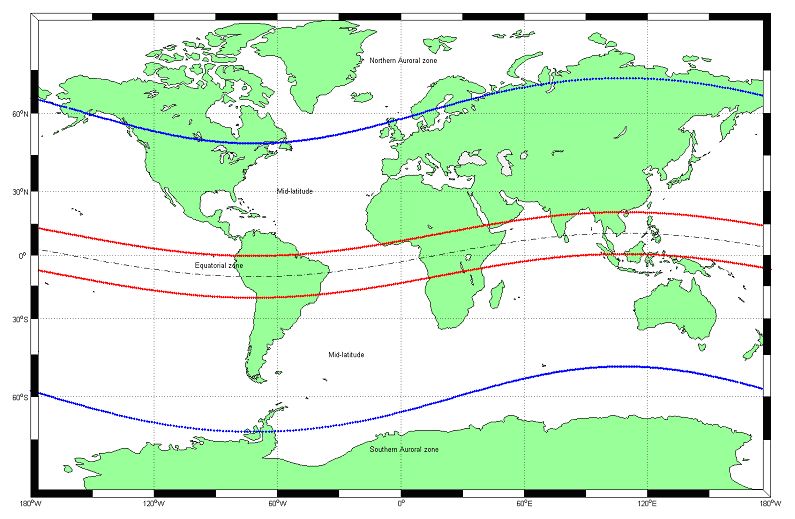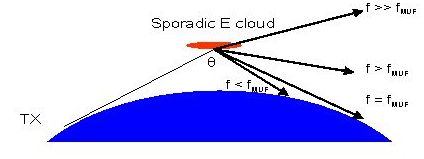

This section deals with the extended propagation VHF via scatter Sporadic E clouds
The Detailed propagation course
HTML Propagation Fundamentals - Fixed Link Propagation - Mobile Propagation
PDF Fixed Links Propagation - Mobile propagation
Short and simple (the old tutorial)
Propagation in Free Space - Absorption by Atmospheric Gases - Diffraction over Terrain - Refraction and Ducting - Reflections - Troposcatter - Rainscatter - Sporadic E
Sporadic E Mode
Sporadic E or Es is a propagation mode via the ionosphere which can allow VHF signals (30-300 MHz) to propagate over long distances via a reflection from the E layer. Sporadic E is generally classified into three types by, Mid-latitude, Equatorial and Auroral. Here equatorial relates to within approximately 10 degrees of the Geomagnetic equator. Equatorial sporadic E is closely associated with the electrojet, an intense electric current within the E layer that travels around the geomagnetic equator during daytime. Here in Europe we generally experience mid-lattitude sporadic E which reaches a maximum in the summer. From the propagation side, we don't really need to know what causes it, just what it does, but it is useful to have a vague idea of the mechanism.

Geomagnetic equator and auroral zones
The E region of the ionosphere extends from about 90-160km above the surface.In the daytime the concentration of free electrons can reach 100,000 per cubic centimetre, around one tenth of the F-layer concentration. Sporadic E is a sporadic concentration of the E layer ionisation into thin layers of high ionisation density that are able to reflect radio waves at much higher frequencies than normal. These thin layers are in the form of patches, "clouds" of maybe 100km in horizontal extent but only a few km thick. This is why sporadic E propagation, is so variable, especially at higher VHF frequencies. For a signal to propagate via Es a cloud of sufficient ionisation must exist at the mid-path point. Just like the F layer, a sporadic E cloud will support a maximum frequency, above this frequency signals will not be reflected to earth. Because of the limited size of the cloud the areas where propagation occurs are also limited.

Sporadic E skip
Unlike F-layer propagation, mid-latitude sporadic E does not appear to be correlated with the solar cycle. F-layer propagation at HF is caused by the presence of free electrons. In the E layer ions are also important, principally O+, O++, NO+, Fe+, Mg+. The ionisation is caused by solar radiation.
Equatorial Sporadic E
Equatorial sporadic E is associated with plasma instabilities in the equatorial electrojet. This current is caused by the solar driven winds in the neutral gases and ions of E-layer which in the day time lead to a build up of positive charge at the dawn terminator and in the generate an electric field oriented west-east. The magnetic field is horizontal at the geomegnetic equator. Electrons moving along with the neutral winds within about 3 degrees of the geomagnetic equator drift upwards resulting in a potential difference across the E layer, which becomes negatively charged at the top and positively charged at the bottom. This potential difference prevents the electrons drifiting further above the E-layer and insted they tend to move westwards along the west-east oriented electric field. This produces is electruc current flowing east, the equatorial electrojet. The Ions do not move in the opposite direction because they are much more massive and constrained by collsions with the neutral gas.
Mid Latitude Sporadic E
How ions become concentrated into thin layers at mid latitudes is still under debate, probably the most accepted current theory is that is is caused by ionospheric wind shear. At the height of the E-layer, the majority of the gas is still unionised; it is also very sparse and would probably be considered a fairly hard vacuum on earth. The ions are relatively heavy compared to the free electrons and their motion is controlled by that of the neutral gas as well as by the magnetic field. Because the overall gas density is low, metallic ions (Fe+,Mg+) can remain ionised for a long enough period to be concentrated into sporadic E clouds under the influence of the winds and the earth's magnetic field. Ions moving faster will experience a greater electromotive force due to the magnetic field and will therefore migrate vertically at different rates than ions moving more slowly.
The occurrence of mid-lattitude sporadic E appears to be correlated with the solar induced ionisation, local noon in the summer. A correlation between meteors and sporadic E is also proposed. This fits in with the wind shear theory as sporadic E is dependent on the long lifetime of metallic ions and meteors are the main source of metallic ions in the ionosphere. There are several meteor storms in June/July/August which correspond with the sporadic E "season" in the Northern hemisphere. Unfortunately the sporadic E season frequently precedes the meteor storms and also has a winter peak not associated with an increase in meteors. While the meteors undoubtedly contribute to sporadic E they do not appear to trigger the mechanism.
Sporadic E clouds once formed tend to move about slowly following the neutral air currents, these can be in any direction but are mainly North/South and at speeds of up to 100MPH, and occasionally faster. The effect of this is well known to radio amateurs as the regions where contacts can be made via sporadic E openings which are highly localised at VHF tend to move around.
Auroral Sporadic E
Auroral sporadic E is caused by the injection of energetic particles (electrons) travelling along magnetic field lines into the E layer. Auroral sporadic E tends to occur at night time peaking around 4am.
Sporadic E prediction
Forget about predicting when sporadic E paths will occur, we can't because it's sporadic. What we can predict a probability that sporadic E will occur based on long term statistics. We can also predict how strong signals are likely to be, so we might say something like there is a 1% probability that there will be a 15 minute sporadic E opening in June where 144MHz signals will be strong enough to make contact between two given stations 1500 miles apart, or that the 50MHz band will be open between the UK and Italy at mid-day for 20% of days during the summer.
To predict the sporadic E field strength we can make use of the parameter "foEs" that is provided hourly by many ionosondes throughout the world. This is the critical frequency for sporadic E, which is the maximum frequency a signal transmitted by the ionosonde will be reflected back by a sporadic E cloud. It is not a very easy parameter to measure. Typical values are around 3 MHz but can rise to up to over 20 MHz on very rare occasions. The picture below shows the predicted forward scatter field strength given 1kW EIRP for 50MHz to 144MHz for FoEs varying between 10 and 20 MHz, the simulation was limited to two hops. An FoEs of 10MHz is quite common, perhaps 1% of the total time in Europe, and 20MHz is very very rare. Signals should be receivable down to 1 uV/m depending on the receiving station, probably down to 0.1 uV/m on 144 MHz with a decent set up. This demonstrates quite nicely what is observed in practice, with openings being much more widespread on 50MHz than on 144 MHz. On 144 MHz contacts are likely to be limited to a small range of distances around 2000km.

© Mike Willis December 26th, 2006